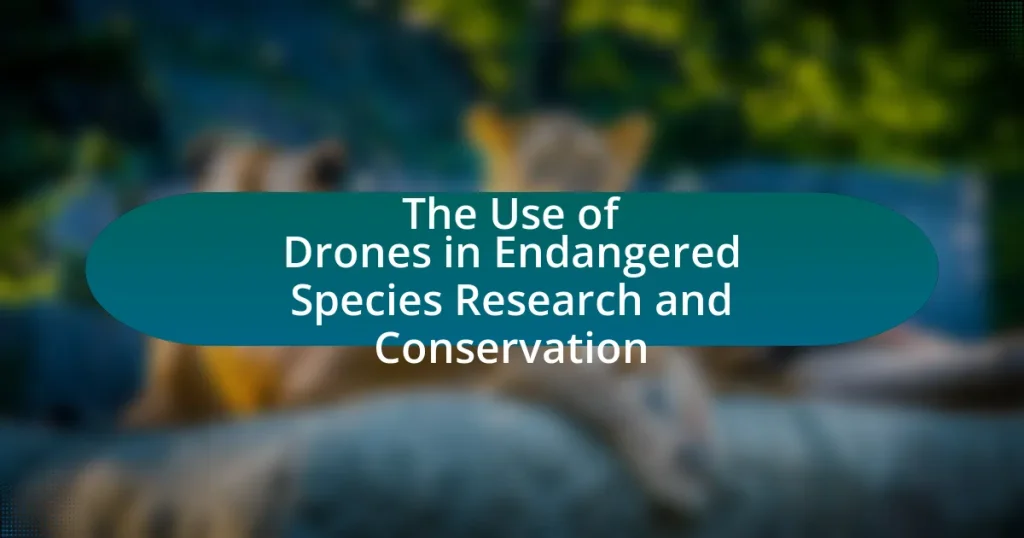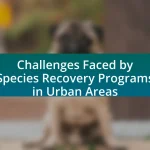Drones, or unmanned aerial vehicles (UAVs), are increasingly utilized in endangered species research and conservation to monitor wildlife populations and habitats effectively. This article explores the various applications of drones, including their ability to collect high-resolution imagery, assess habitat conditions, and track animal movements while minimizing human disturbance. It discusses the advantages of drones over traditional methods, such as cost-effectiveness and enhanced data collection capabilities, as well as the different types of drones used in conservation efforts. Additionally, the article addresses the challenges and ethical considerations associated with drone usage, emphasizing best practices for effective implementation in wildlife research.
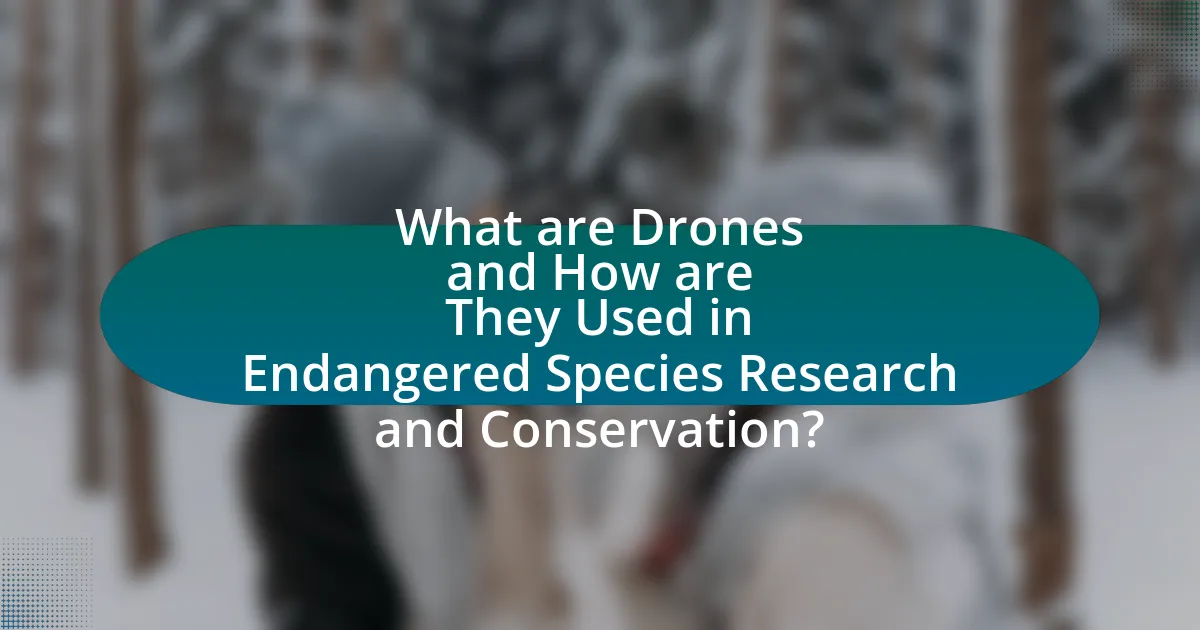
What are Drones and How are They Used in Endangered Species Research and Conservation?
Drones are unmanned aerial vehicles (UAVs) equipped with cameras and sensors, utilized in endangered species research and conservation to monitor wildlife populations and habitats. These devices enable researchers to collect high-resolution aerial imagery and data without disturbing the animals or their environments. For instance, studies have shown that drones can effectively survey large areas, track animal movements, and assess habitat conditions, leading to more informed conservation strategies. A specific example includes the use of drones in monitoring the nesting sites of endangered sea turtles, where researchers have successfully documented nesting behavior and population trends from a safe distance.
How do drones contribute to the monitoring of endangered species?
Drones significantly enhance the monitoring of endangered species by providing high-resolution aerial imagery and real-time data collection. These unmanned aerial vehicles can access remote and difficult terrains, allowing researchers to track animal populations, assess habitat conditions, and identify threats such as poaching or habitat destruction. For instance, a study published in the journal “Remote Sensing” demonstrated that drones could effectively monitor the population of endangered species like the black rhinoceros, achieving a detection accuracy of over 90%. This capability not only improves the efficiency of conservation efforts but also reduces human disturbance to wildlife, thereby promoting better outcomes for endangered species.
What specific data can drones collect for conservation efforts?
Drones can collect various specific data for conservation efforts, including high-resolution imagery, thermal data, and multispectral data. High-resolution imagery allows for detailed mapping of habitats and monitoring of land use changes, while thermal data can be used to detect wildlife presence and behavior, particularly for nocturnal species. Multispectral data enables the assessment of vegetation health and biodiversity by analyzing different wavelengths of light reflected from plants. Studies have shown that drones can cover large areas quickly, providing timely and accurate data essential for effective conservation management.
How do drones enhance the efficiency of wildlife surveys?
Drones enhance the efficiency of wildlife surveys by providing high-resolution aerial imagery and real-time data collection, which allows researchers to cover large areas quickly and accurately. This technology enables the monitoring of wildlife populations and habitats without disturbing the animals, leading to more reliable data. For instance, a study published in the journal “Remote Sensing” demonstrated that drones could reduce survey time by up to 80% compared to traditional ground methods while increasing the detection rates of species by capturing detailed images from various altitudes.
What are the advantages of using drones in conservation compared to traditional methods?
Drones offer significant advantages in conservation compared to traditional methods, primarily through enhanced data collection, cost-effectiveness, and reduced human impact. Drones can cover large areas quickly and efficiently, capturing high-resolution images and data that would be time-consuming and expensive to gather using ground surveys or manned aircraft. For instance, a study published in the journal “Remote Sensing” demonstrated that drones could reduce the time required for wildlife monitoring by up to 90% while providing more accurate population estimates. Additionally, drones minimize disturbance to wildlife, allowing for more natural behavior observation, which is crucial for effective conservation strategies.
How do drones reduce human impact on wildlife during research?
Drones reduce human impact on wildlife during research by enabling remote data collection without physical intrusion into habitats. This technology allows researchers to monitor animal behavior, population dynamics, and habitat conditions from a distance, minimizing stress on wildlife. For example, studies have shown that using drones for aerial surveys can significantly decrease disturbance compared to traditional ground-based methods, which often lead to animals fleeing or altering their natural behaviors. Additionally, drones can access hard-to-reach areas, further reducing the need for human presence in sensitive environments.
What cost benefits do drones provide for conservation projects?
Drones provide significant cost benefits for conservation projects by reducing the need for extensive manpower and minimizing operational expenses. Traditional methods of data collection, such as ground surveys and manned aircraft, can be labor-intensive and costly, often requiring teams of researchers and substantial funding for equipment and logistics. In contrast, drones can cover large areas quickly and efficiently, allowing for the collection of high-resolution aerial imagery and data at a fraction of the cost. For example, a study by Anderson and Gaston (2013) demonstrated that using drones for wildlife monitoring reduced costs by up to 90% compared to traditional methods. This efficiency not only lowers financial barriers for conservation initiatives but also enables more frequent monitoring and data collection, ultimately enhancing the effectiveness of conservation efforts.
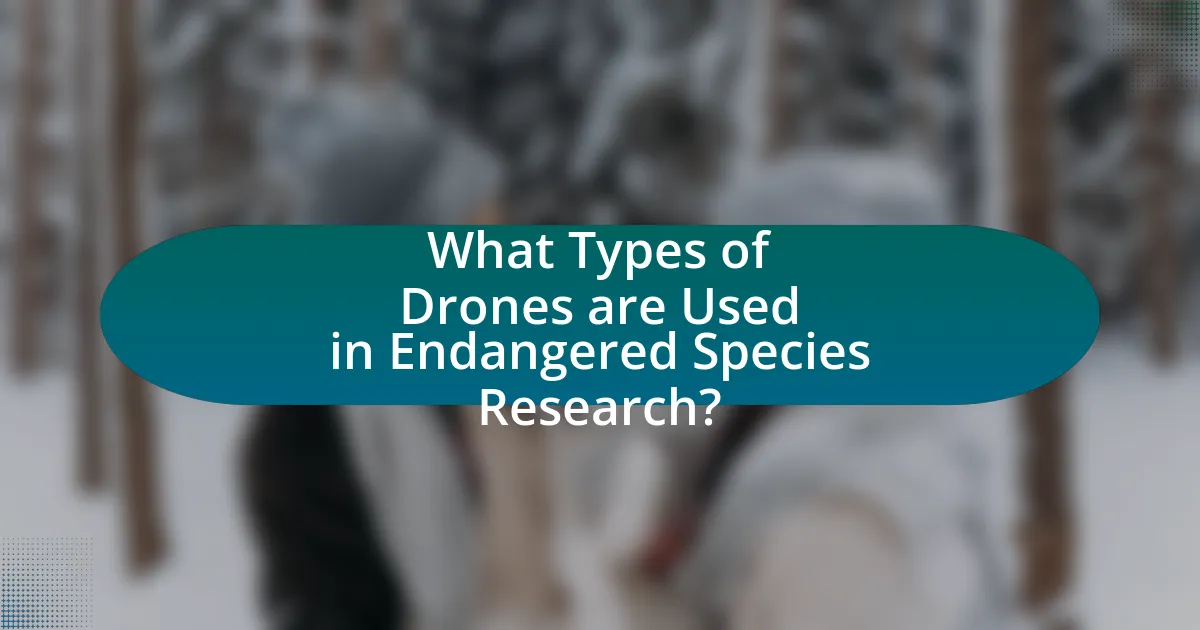
What Types of Drones are Used in Endangered Species Research?
Various types of drones are utilized in endangered species research, including fixed-wing drones, multi-rotor drones, and hybrid drones. Fixed-wing drones are effective for covering large areas and can fly longer distances, making them suitable for surveying vast habitats. Multi-rotor drones, on the other hand, offer greater maneuverability and are ideal for detailed observations in smaller areas, allowing researchers to capture high-resolution images and videos of species in their natural environments. Hybrid drones combine features of both fixed-wing and multi-rotor designs, providing versatility for different research needs. These drones are equipped with advanced sensors and cameras, enabling researchers to monitor wildlife populations, track movements, and assess habitat conditions, thereby contributing significantly to conservation efforts.
What are the different categories of drones utilized in conservation efforts?
The different categories of drones utilized in conservation efforts include fixed-wing drones, multi-rotor drones, hybrid drones, and tethered drones. Fixed-wing drones are effective for covering large areas and are often used for mapping and surveying habitats. Multi-rotor drones are versatile and can hover, making them suitable for close-up monitoring of wildlife and vegetation. Hybrid drones combine features of both fixed-wing and multi-rotor designs, allowing for extended flight times and varied applications. Tethered drones provide continuous power and are used for real-time monitoring in specific locations. These categories are validated by their specific applications in conservation, such as habitat mapping, wildlife tracking, and anti-poaching efforts.
How do fixed-wing drones differ from multi-rotor drones in their applications?
Fixed-wing drones differ from multi-rotor drones primarily in their flight capabilities and applications. Fixed-wing drones are designed for long-distance flights and can cover larger areas more efficiently, making them suitable for mapping and surveying vast landscapes in conservation efforts. In contrast, multi-rotor drones excel in vertical takeoff and landing, allowing for precise maneuverability and the ability to hover, which is beneficial for close-up monitoring of endangered species and their habitats. For instance, fixed-wing drones can be used for aerial surveys over large national parks, while multi-rotor drones are often employed for detailed inspections of specific areas, such as nesting sites or animal tracking.
What are the advantages of using hybrid drones in wildlife research?
Hybrid drones offer significant advantages in wildlife research, primarily through their ability to combine the benefits of both fixed-wing and multi-rotor designs. This versatility allows hybrid drones to cover large areas efficiently while also providing the capability for precise, low-altitude observations. For instance, hybrid drones can fly long distances at higher speeds, which is essential for monitoring expansive habitats, while also hovering to capture detailed images or collect data on specific wildlife species.
Additionally, hybrid drones can operate in various environmental conditions, enhancing their usability in diverse ecosystems. Their extended flight times, often exceeding those of traditional drones, enable researchers to gather more comprehensive data during a single mission. Studies have shown that using hybrid drones can reduce the time and costs associated with wildlife surveys, making them a valuable tool for conservation efforts.
What features should conservation drones have for effective research?
Conservation drones should have high-resolution cameras, GPS capabilities, long flight times, and the ability to carry various sensors for effective research. High-resolution cameras enable detailed imagery for monitoring wildlife and habitats, while GPS capabilities ensure precise location tracking of species and environmental changes. Long flight times are essential for covering large areas without frequent recharging, which is critical in remote or expansive habitats. Additionally, the ability to carry sensors, such as thermal imaging or multispectral cameras, allows researchers to gather diverse data types, enhancing the understanding of species behavior and ecosystem health. These features collectively improve data collection efficiency and accuracy in conservation efforts.
How does camera technology impact the effectiveness of drones in monitoring species?
Camera technology significantly enhances the effectiveness of drones in monitoring species by providing high-resolution imagery and advanced imaging capabilities. High-resolution cameras enable detailed observation of wildlife, allowing researchers to identify species, assess population sizes, and monitor behaviors from a distance without disturbing habitats. Additionally, thermal imaging cameras can detect heat signatures, making it easier to locate animals in dense vegetation or during nighttime, which is crucial for studying elusive or endangered species. Studies have shown that drones equipped with these advanced camera systems can cover large areas quickly, increasing data collection efficiency and accuracy, thereby improving conservation efforts.
What role does battery life play in the operational capacity of conservation drones?
Battery life is crucial for the operational capacity of conservation drones as it directly determines the duration and range of their missions. A longer battery life enables drones to cover larger areas, conduct extended surveys, and gather more data without needing to return for recharging. For instance, drones with a battery life of over 30 minutes can effectively monitor wildlife populations and habitats, while those with shorter battery lives may limit the scope of their operations, potentially missing critical data. Therefore, the efficiency and effectiveness of conservation efforts are significantly influenced by the battery life of the drones used in these initiatives.
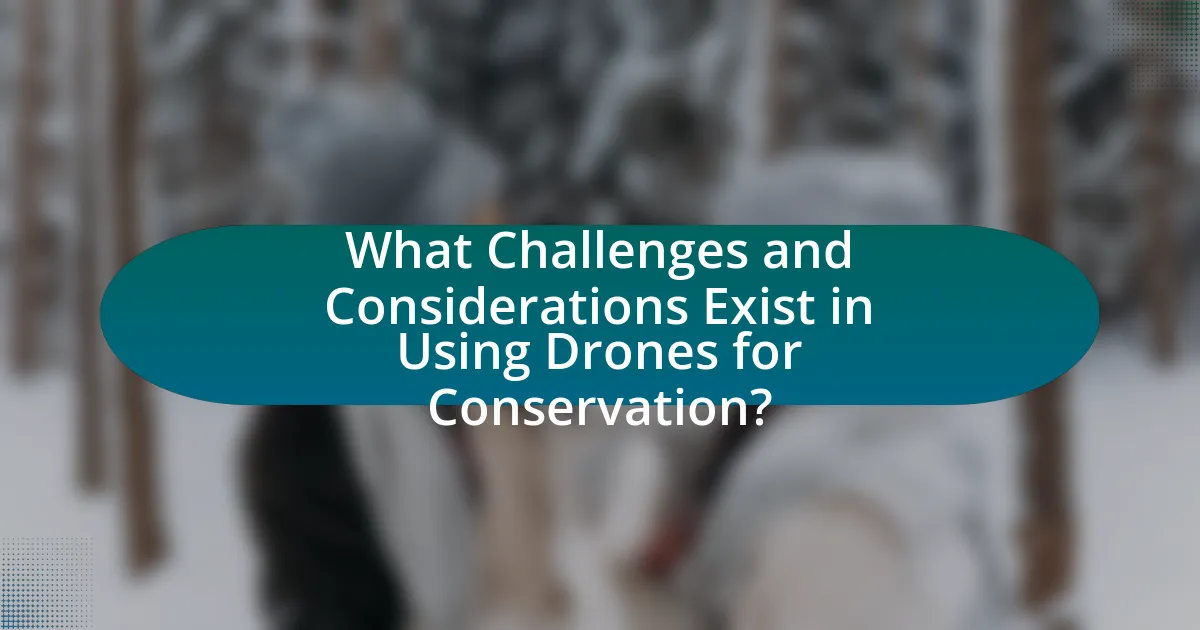
What Challenges and Considerations Exist in Using Drones for Conservation?
Using drones for conservation presents several challenges and considerations, including regulatory restrictions, technical limitations, and ethical concerns. Regulatory restrictions often involve airspace regulations that can limit where drones can be operated, requiring permits and adherence to local laws. Technical limitations include battery life, payload capacity, and the need for advanced data processing capabilities, which can hinder effective monitoring and data collection. Ethical concerns arise from the potential disturbance to wildlife and habitats, as well as privacy issues related to aerial surveillance. These challenges necessitate careful planning and collaboration with stakeholders to ensure that drone usage aligns with conservation goals while minimizing negative impacts.
What are the ethical considerations when using drones in wildlife research?
The ethical considerations when using drones in wildlife research include minimizing disturbance to animals, ensuring data privacy, and adhering to regulations. Drones can cause stress to wildlife, particularly during sensitive periods such as breeding or nesting, which necessitates careful planning and timing of drone flights to avoid negative impacts. Additionally, researchers must respect the habitats of endangered species and avoid intruding on protected areas without proper permissions. Compliance with local and international laws governing wildlife research and drone usage is essential to uphold ethical standards. Studies have shown that responsible drone use can enhance conservation efforts while mitigating potential harm, emphasizing the importance of ethical guidelines in wildlife research.
How can drone usage affect animal behavior and habitats?
Drone usage can significantly affect animal behavior and habitats by causing stress and altering movement patterns. Research indicates that the presence of drones can lead to increased flight responses in wildlife, particularly in sensitive species such as birds and mammals. For instance, a study published in the journal “Biological Conservation” found that raptors exhibited avoidance behavior when drones were present, which could disrupt their hunting and nesting activities. Additionally, drones can impact habitats by disturbing breeding sites and altering foraging patterns, as animals may flee from perceived threats, leading to changes in local biodiversity and ecosystem dynamics.
What regulations must be followed when deploying drones for conservation purposes?
When deploying drones for conservation purposes, operators must adhere to regulations set by aviation authorities, such as the Federal Aviation Administration (FAA) in the United States. These regulations include obtaining a Remote Pilot Certificate, ensuring the drone is registered, and following specific operational guidelines, such as maintaining visual line of sight and adhering to altitude restrictions. Additionally, operators must comply with local wildlife protection laws, which may require permits for flying over certain habitats or during specific times to minimize disturbance to endangered species. For example, the Endangered Species Act mandates that any activity that may harm listed species must be evaluated and permitted accordingly.
What technical challenges do researchers face when using drones?
Researchers face several technical challenges when using drones, including limited battery life, regulatory restrictions, and data processing difficulties. Limited battery life restricts flight duration and operational range, often requiring frequent recharging or battery swaps, which can hinder data collection efforts. Regulatory restrictions, such as airspace limitations and required permits, complicate deployment in certain areas, particularly in protected habitats. Additionally, data processing difficulties arise from the need to analyze large volumes of data collected by drones, which can require advanced software and significant computational resources. These challenges can impede the effectiveness of drones in endangered species research and conservation efforts.
How can data accuracy be ensured when using drones for species monitoring?
Data accuracy in species monitoring using drones can be ensured through high-resolution imaging, precise GPS technology, and rigorous data validation methods. High-resolution cameras capture detailed images that allow for accurate identification and counting of species, while advanced GPS systems provide precise location data, essential for tracking movements and habitat use. Additionally, implementing ground-truthing techniques, where drone data is verified against field observations, enhances reliability. Studies have shown that combining drone data with traditional survey methods can improve accuracy by up to 30%, demonstrating the effectiveness of these approaches in ecological research.
What are common technical failures that can occur with conservation drones?
Common technical failures that can occur with conservation drones include battery malfunctions, GPS signal loss, and camera system failures. Battery malfunctions can lead to unexpected power loss during flight, which is critical for data collection and monitoring. GPS signal loss can result in navigation errors, causing drones to stray from their intended flight paths, potentially missing important areas for observation. Camera system failures can hinder the ability to capture high-quality images or videos, which are essential for monitoring wildlife and habitats. These issues have been documented in various studies, highlighting the importance of regular maintenance and pre-flight checks to mitigate risks associated with drone operations in conservation efforts.
What Best Practices Should Be Followed When Using Drones in Endangered Species Research?
Best practices for using drones in endangered species research include ensuring compliance with local regulations, minimizing disturbance to wildlife, and utilizing appropriate technology for data collection. Compliance with regulations, such as obtaining necessary permits and following flight restrictions, is crucial to avoid legal issues and protect sensitive habitats. Minimizing disturbance involves flying at safe altitudes and avoiding sensitive times, such as breeding seasons, to reduce stress on the species being studied. Additionally, employing high-resolution cameras and thermal imaging can enhance data quality while ensuring that the drones operate quietly to limit disruption. These practices are supported by studies indicating that responsible drone use can effectively monitor wildlife populations without causing significant harm.
How can researchers effectively plan drone flights for maximum data collection?
Researchers can effectively plan drone flights for maximum data collection by utilizing precise flight paths, optimal altitude settings, and appropriate sensor selection. By mapping out specific areas of interest and scheduling flights during ideal weather conditions, researchers can enhance data quality and coverage. Studies have shown that flying at altitudes between 100 to 400 feet maximizes visibility and detail in imagery, which is crucial for monitoring endangered species. Additionally, employing multispectral or thermal sensors allows for the collection of diverse data types, such as vegetation health and animal heat signatures, thereby enriching the overall dataset.
What training is necessary for personnel operating drones in conservation efforts?
Personnel operating drones in conservation efforts require comprehensive training that includes drone piloting skills, knowledge of conservation principles, and understanding of relevant regulations. This training ensures that operators can effectively collect data while minimizing disturbance to wildlife and habitats. For instance, operators must be proficient in navigating drones in various environmental conditions and be familiar with the specific conservation goals of their projects, such as monitoring endangered species or assessing habitat health. Additionally, training often includes instruction on data analysis and interpretation, enabling personnel to make informed decisions based on the information gathered.
